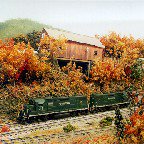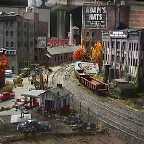Weathering
Everything on model trains, model railroads, model railways, locomotives, model train layouts, scenery, wiring, DCC and more. Enjoy the world's best hobby... model railroading!
Readers might like to share their ideas and experiences and have a go at answering this question posed by a fellow model railroading enthusiast.
“I would like to design a diarama showing an after rain shower with puddles, water stains on the rolling stock and wet ballest. But I am at a loss as what to use to similate hard packed soil between the ties on the sidings from years of wind and dust which would eventually cover the ballest. I was told not to use plaster as it would crack. Any suggestions?”
This model railroad blog is for all model railroading enthusiasts so please feel free to contribute and share your ideas with other readers.
Many model train passenger cars that are being retailed don’t have interiors. As a result when you look inside them they look like a toy train.
One simple solution is to buy some commercial window tinting film from hobby, hardware or car accessory store. A small strip of the tinting film can be attached to the inside of the clear plastic that makes up the windows of most passenger cars. The tinting film can look like polarized glass which is very difficult to look through.
We’ve all walked down city streets and observed the less than perfect side to real city life. So, why make a cityscape on your model railroad layout look like a scene from Fantasy Island.
When modeling an urban scene, never forget the garbage that could be present. What about adding an old newspaper, some garbage cans, cracks in the pavement, graffiti, an old rundown shack, perhaps piles of junk, a broken-down old car and scrape outside of major industry or railyard.
Although you don’t want to overdo it, a bit of imperfection will add to the reality of most city scenes. Look around you and come up with your own ideas.
Shiny surfaces can spoil the realism of any model railroad. Shiny surfaces can make structures and rolling stock look fake as though they have just come out of the packaging.
A simple way to remove that shine is to overspray the structure or rolling stock with Dullcote (Testors #1260 clear flat lacquer overcoat). Dullcote is available at most hobby stores/model railroad stores and comes in a small spray can like many other model car paint colors.

The first RS-11s were produced by Alco in early 1956. This locomotive, classified by Alco as model DL-701, was their replacement for the very popular RS-3 road-switcher. Featuring a V-12, 1,800hp 251B diesel engine, the RS-11 was Alco’s answer to EMD’s very successful GP9. The turbocharged RS-11 accelerated faster, had a higher tractive effort rating and typically used less fuel than the competition. It was also quite versatile and could be found in heavy haul freight as well as passenger service.
Features Include:
For more information on the Atlas HO RS-11 Locomotives be sure to visit the Atlas model Train website at http://www.atlasrr.com/HOLoco/hors11a.htm
Weathering, is basically the art of taking something new and making it look like something old. It could be locomotive, caboose, a building, a bridge, a tunnel, a road, a fence, or any element of scenery for that matter. Almost anything ages and changes over time.
For example; when you buy a some rolling stock it comes packaged all shiney, plastic and new. It probably looks too perfect, unreal and out of place alongside the other cars on the track. It may need “roughing up” to make it look used, or at least show some signs of wear and tear.
It really comes down to deciding if want to “rough-up” the factory paint job on the very expensive rolling stock you’ve just purchased. But, like it or not, shiny new cars usually look out of place on an otherwise “used looking” layout.
In reality; most cars on a railroad show varying degrees of rust, grime (lube and oil), mud, soot, denting, scratches and some are even covered in graffiti. However, cars do vary in age and useage, so they shouldn’t necessarily all look the same. And, not everything is dirty, because the contact on bare metal can keep some areas clean.
So, it is a case of thinking carefully about the age and likely wear and tear that you want to mimic… and whether you are prepared to “rough-up” your rolling stock for the sake of adding realism.
Also, think about the region or era you are recreating with your model train layout. Is it likely to be muddy at times or would it be more dusty and arrid like in a desert? For example, the rolling stock might need a sunbleached look, which can be achieved with dullcoat brushed over with some rubbing alcohol. This will give the model a kind of a white milky haze. If you don’t like it, respray with dullcoat.
However, always test techniques on something else before you try them out on your prized model train models, because you may not like the effect.

Scenery on the Housatonic Model Railway Club layout is mainly fall (autumn) colors with a walk-around plan designed for scenery and operations.
Founded in 1972, the Housatonic Model Railway Club was started to further the enjoyment of the model railroad hobby, primarily through the building and operation of an H0 scale model railroad. The model railroad club layout broadly followed what the Housatonic Railroad (which was swallowed by the New Haven around 100 years ago) might have looked like in the 1950’s, had it remained independent.

The Housatonic Model Railway Club hosts the Station Stop model railroad show and sale at the Fairfield Ludlowe High School in Fairfield each March. The show features operating layouts and displays by model railroad dealers.
Weathering (showing signs of wear and tear) can add to the realism of any model train set, but it needs to be done carefully. One, often overlooked, important consideration is the age of the individual freight wagon being weathered. Not all wagons on a freight train are necessarily of the same vintage or have experienced the same weathering conditions. A freight train could comprise a mix of fairly new and considerably old wagons.
For example a model train layout depicting a mid 1960’s railroad might comprise mainly of wagons built around 1950. That would make most of the wagons around 15 years old.
Compare this to a freight train on a modern day railroad layout. Today’s freight train might include several brightly colored newish wagons along with a couple of 35-40 year old wagons built around the mid to late 1960’s. Weathering of the older 1960’s wagons would be different to that seen on the newer wagons.
So, always consider that a freight train is made up of several different wagons of different ages and backgrounds rather than all the wagons on a train being constructed at the same time and experiencing the same weathering conditions.
The Black Diamond Lines Model Railroad Club models in HO scale, which is a ratio of 1:87. This means that if a model is 1 foot long, it represents a real-life object that is 87 feet long. (One foot, in HO scale is actually 0.137 of an inch.) The layout occupies approximately 1500 square feet of space, with a track elevation range from 46 inches to 82 inches above the floor.

Above: This engine is an SD70M. MU cables, air hoses, gps receiver, and ditch lights are just a few of the extras that have been added.

Above: An EMD-SD70 Deminstrator. Three were made, 7000, 7001 and 7002, all which can be seen on the BDL right of way. Again extra details have been added for that prototypical look.
The Black Diamond Lines is an active, operating HO scale model railroad club located in Antioch, CA.
Realistic looking scenery is important on model train set layouts. To model weeds, hay, straw, and grass get some “binder twine” from a farmer/horse owner. The twine is a natural (unlike the new plastic stuff) material that takes paint/stain well. It also weathers naturally. Hang some outside for a year and it will look like fall weeds, let it lay on the ground and it will get a grayish color. The twine can be cut in very short lengths and used as some ground cover.
Shiny surfaces can spoil the realism of any model train set layout. Shiny surfaces can make model buildings and model trains look fake as though they have just come off a shop shelf.
A simple way to remove that shine is to overspray the structure or rolling stock with Dullcote (Testors #1260 clear flat lacquer overcoat). Dullcote is available at most model train hobby stores and comes in a small spray can like many other model car colors.
Get all the latest model railway news and views from the world of model trains. Stay up to date in the most enthralling (ok I’m biased) hobby in the world… model railroading!